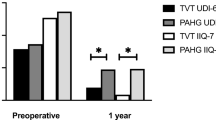Abstract
This prospective, open label, multicenter, and observational study was performed to determine the efficacy, safety, and the impact of this procedure on the current quality of life (QOL). One hundred three women underwent the intravaginal slingplasty (IVS) procedure. The postoperative evaluation consisted of clinical examination, Incontinence Quality of Life (I-QOL) questionnaire, 3-day consecutive frequency volume chart, free flowmetry, and measurement of post void residual. At 12 months, 83 patients have completed follow-up and are included in this analysis. Patient assessment of continence revealed 89.2% (74/83) cure rate. During follow-up period, one patient (1.2%) has presented with vaginal erosion of the sling material. The I-QOL showed significant improvement in total and three subscale scores at 12 months of follow-up period. This study demonstrated that the IVS procedure provides a safe and effective means for the treatment of female stress incontinence and improvement of QOL.
Similar content being viewed by others
References
Bemelmans BL, Chapple CR (2003) Are slings now the gold standard treatment for the management of female urinary stress incontinence and if is so what technique? Curr Opin Urol 13:301–307
Amid PK (1997) Classification of biomaterials and their related complications in abdominal wall hernia surgery. Hernia 1:15–21
Lim YN, Muller R, Corstiaans A, Dietz HP, Barry C, Rane A (2005) Suburethral slingplasty evaluation study in North Queensland, Australia: the SUSPEND trial. Aust N Z J Obstet Gynaecol 45:52–59
Rechberger T, Rzezniczuk K, Skorupski P et al (2003) A randomized comparison between monofilament and multifilament tapes for stress incontinence surgery. Int Urogynecol J Pelvic Floor Dysfunct 14:432–436
Abrams P, Cardozo L, Fall M et al (2002) The standardization of terminology of lower urinary tract function: report from the Standardisation Sub-Committee of the International Continence Society. Am J Obstet Gynecol 187:116–126
Petros PE, Ulmsten UI (1993) An integral theory and its method for the diagnosis and management of female urinary incontinence. Scand J Urol Nephrol 153(Suppl 1):1093
Ulmsten U, Henriksson L, Johnson P, Varhos G (1996) An ambulatory surgical procedure under local anesthesia for treatment for female urinary incontinence. Int Urogynecol J Pelvic Floor Dysfunct 7:81–86
Stamey TA (1980) Endoscopic suspension of the vesical neck for urinary incontinence in females. Report on 203 consecutive patients. Ann Surg 192:465–471
Young SB, Howard AE, Baker SP (2001) Mersilene mesh sling: short- and long-term clinical and urodynamic outcomes. Am J Obstet Gynecol 185:32–40
Weinberger MW, Ostergard DR (1995) Long-term clinical and urodynamic evaluation of the polytetrafluoroethylene suburethral sling for treatment of genuine stress incontinence. Obstet Gynecol 86:92–96
Giberti C, Rovida S (2000) Transvaginal bone-anchored synthetic sling for the treatment of stress urinary incontinence: an outcomes analysis. Urology 56:956–961
Petros PP (1999) Medium-term follow-up of the intravaginal slingplasty operation indicates minimal deterioration of urinary continence with time. Aust N Z J Obstet Gynaecol 39:354–356
Meschia M, Pifarotti P, Bernasconi F et al (2006) Tension-free vaginal tape (TVT) and intravaginal slingplasty (IVS) for stress urinary incontinence: a multicenter randomized trial. Am J Obstet Gynecol 195:1338–1342
Ulmsten U, Petros P (1995) Intravaginal slingplasty (IVS): an ambulatory surgical procedure for treatment of female urinary incontinence. Scand J Urol Nephrol 29:75–82
Ward KI, Hilton P, UK and Ireland TVT trial group (2004) A prospective multicenter randomized trial of tension-free vaginal tape and colposuspension for primary urodynamic stress incontinence: two years follow-up. Am J Obstet Gynecol 190:324–331
Dietz HP, Vancaillie P, Svehla M, Walsh W, Steensma AB, Vancaille TG (2003) Mechanical properties of urogynecologic implant materials. Int Urogynecol J Pelvic Floor Dysfunct 14:239–243
Segal JL, Vassallo B, Kleeman S, Silva WA, Karram MM (2004) Prevalence of persistent and de novo overactive bladder symptoms after the tension-free vaginal tape. Obstet Gynecol 104:1263–1269
Nilsson CG, Falconer C, Rezapour M (2004) Seven-year follow-up of the tension-free vaginal tape procedure for treatment of urinary incontinence. Obstet Gynecol 104:1259–1262
Levin I, Groutz A, Gold R, Pauzner D, Lessing JB, Gordon D (2004) Surgical complications and medium-term outcome results of tension-free vaginal tape: a prospective study of 313 consecutive patients. Neurourol Urodyn 23:7–9
Glavind K, Sander P (2004) Erosion, defective healing and extrusion after tension-free urethropexy for the treatment for stress urinary incontinence. Int Urogynecol J Pelvic Floor Dysfunct 15:179–182
Siegel AL, Kim M, Goldstein M, Levey S, Ilbeigi P (2005) High incidence of vaginal mesh extrusion using the intravaginal slingplasty sling. 174:1308–1311
Papadimitriou J, Petros P (2005) Histological studies of monofilament and multifilament polypropylene mesh implants demonstrate equivalent penetration of macrophages between fibrils. Hernia 9:75–78
Blaivas JG, Appell RA, Fantl JA et al (1997) Standards of efficacy for evaluation of treatment outcomes in urinary incontinence: recommendations of the Urodynamic Society. Neurourol Urodyn 16:145–147
Oh SJ, Ku JH (2006) Is a generic quality of life instrument helpful for evaluating women with urinary incontinence? Qual Life Res 15:493–501
Oh SJ, Park HG, Lim SH et al (2002) Translation and linguistic validation of Korean version of the Incontinence Quality of Life (QoL) instrument. J Korean Continence Soc 6:10–23
Author information
Authors and Affiliations
Corresponding author
Rights and permissions
About this article
Cite this article
Kim, J.C., Chung, B.S., Choi, J.B. et al. A safety and quality of life analysis of intravaginal slingplasty in female stress incontinence: a prospective, open label, multicenter, and observational study. Int Urogynecol J 18, 1331–1335 (2007). https://doi.org/10.1007/s00192-007-0327-7
Received:
Accepted:
Published:
Issue Date:
DOI: https://doi.org/10.1007/s00192-007-0327-7




